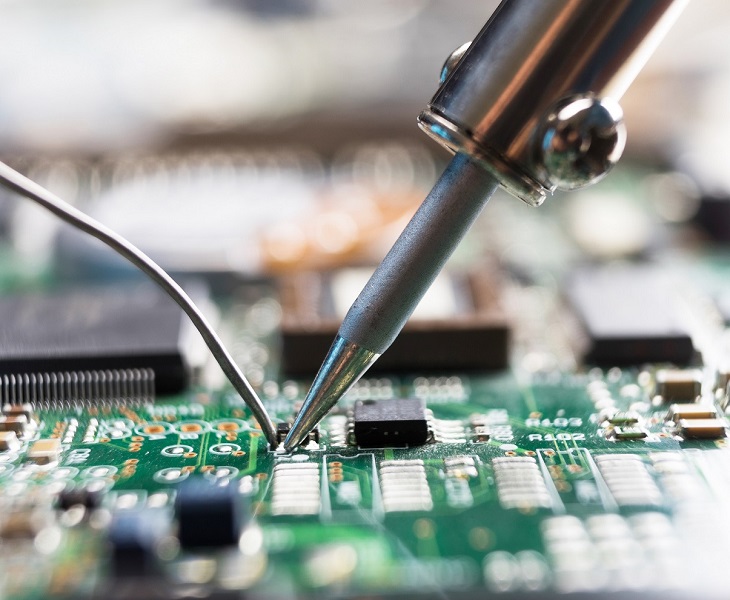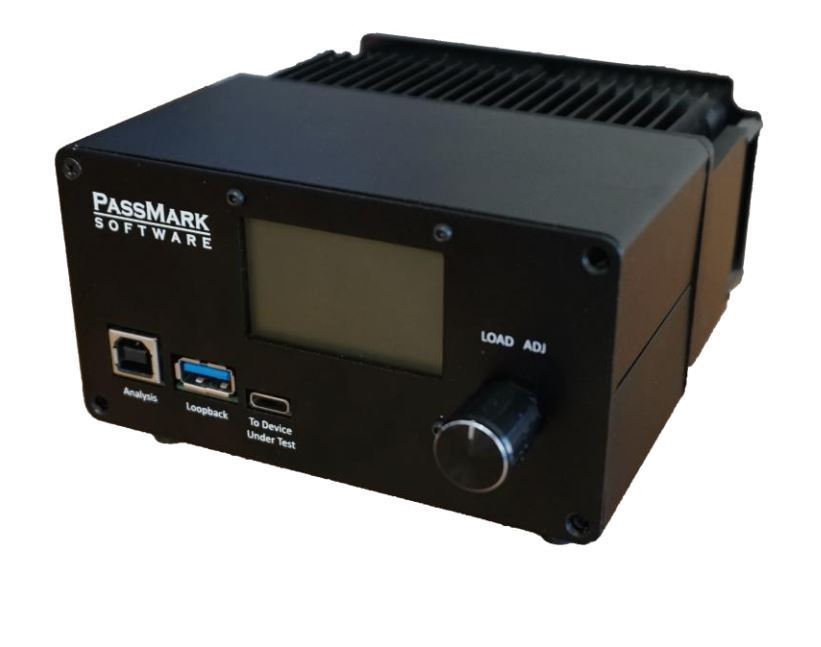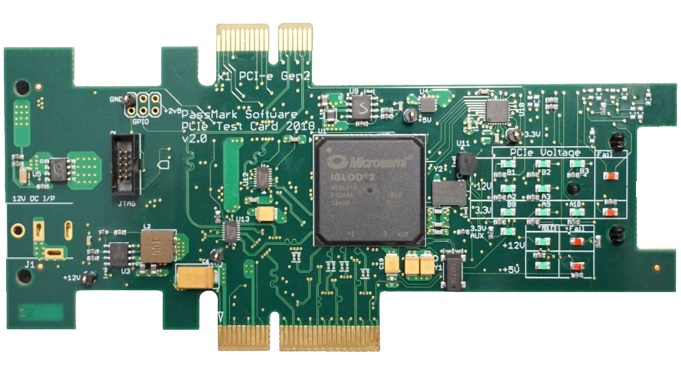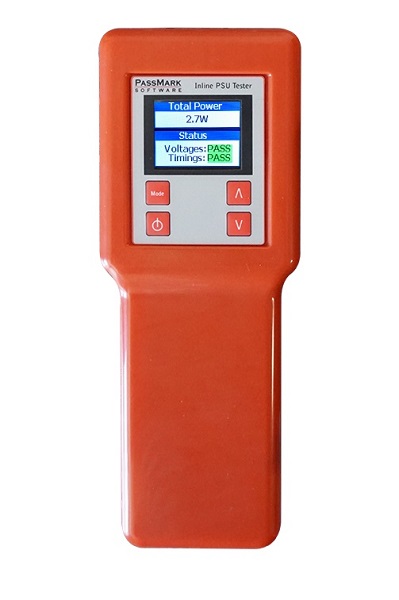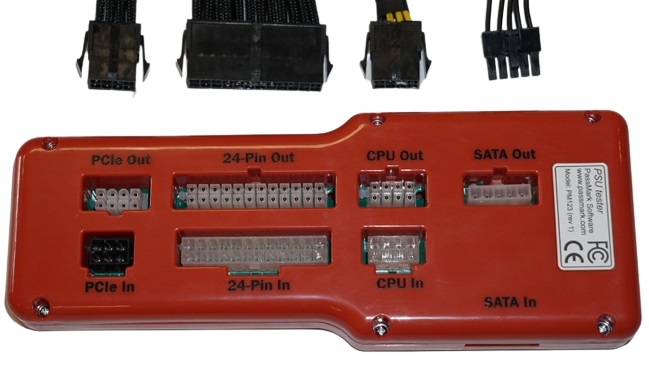Description
The Passmark Power Delivery Tester is an electronic load capable of communicating with Power Delivery devices via the CC (Configuration Channel) line. This allows testing of all power profiles of the Power Delivery 1.0 to 3.0 specification (100W) including Quick Charge (up to QC4+) and PPS to test USB chargers, USB ports and to determine the current capacity of a power bank.
The Power Delivery Tester can also act as a pass-through to measure the power consumed by a consumer. For example, the level of a power peak during switch-on processes can be identified.
The device can be operated via PC with the Power Delivery Test Software as well as in standalone mode. In addition, the PC Power Delivery Test Software has a protocol analysis and a programmable Power Delivery message generator function.
Features
- Test the power delivery capability of USB ports, Thunderbolt ports, USB chargers and USB power banks.
- Check that a USB host is capable of delivering the specified maximum wattage without failing.
- Find out the wattage that a USB charger (wall-wart) claims to support, which in turn controls the charging speed of cell phones and other USB-connected rechargeable devices.
- Check that the voltage values remain within the specifications even under high loads.
- Measure accurate power consumption of USB devices.
- QC4+ and PPS support available in PM125 model.
- Built-in protection against overcurrent, overvoltage, overtemperature and ESD.
- Isolated USB surveillance port to protect surveillance device.
- Standalone and PC software operation
- Use with USB 3.0 Loopback Plug to test USB ports communication speed, data integrity and power delivery simultaneously.

USB Power Supply Test
Tests the power supply capability of USB ports up to 100 watts according to the USB Battery Charging 1.2 and USB Power Delivery standards. Tests the power delivery capability of USB chargers (Detects proprietary chargers and adjusts max current accordingly).
Negotiates voltage levels with host PD controller chip to switch between different voltage levels. Consumes 50 watts continuously and up to 100 watts for short periods. The current can be adjusted with a rotary control or via software with milliampere accuracy.
The tester can be used as a capacity meter to test power banks. The monitoring software monitors the capacity over time until the voltage falls below the
required voltage limit drops. With the "Reset Capacity" button, the user can reset the accumulated capacity. The Power Delivery Tester can also act as a pass-through to measure the power consumed by a consumer. For example, the level of a power peak during switch-on processes can be identified.

Programming Interface
Controllable and configurable via USB interface. API that allows you to change the load, read the current-voltage levels, and update the LCD content.
Bootloader that allows firmware to be updated in the field
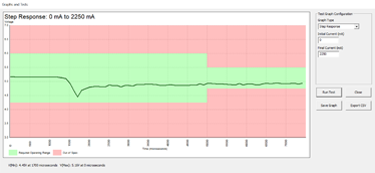
Extended test functions
Measure the electrical ripple at 1 KHz.
Measure the capacity of USB power banks and rechargeable batteries in mAh.
Simultaneously test the communication speed, data integrity and power supply of the USB ports with the optional USB 3.0 loopback connector
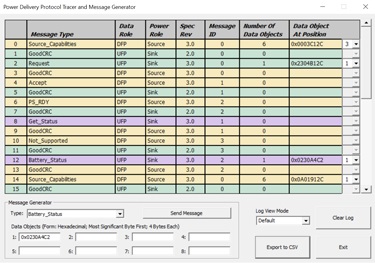
Protocol Analyzer
The Power Delivery Protocol Analyzer records and displays the Power Delivery messages sent to and from the USB charger. Use this to verify that the USB charger conforms to protocol standards through a visual interface.Message Generator
The Power Delivery Protocol message generator creates Power Delivery messages and sends them to a PD device. Test how a charger reacts and responds to user-defined valid and invalid messages.F.A.Q.
USB-PD (PD stands for Power Delivery) is a universal standard that allows a wide range of devices that use USB-C to be quickly charged to deliver more power (greater than 7.5W) to devices with higher power requirements . Devices can request higher currents and supply voltages from compatible USB PD hosts. For example, a phone may request 15W of power while a laptop may request 45W.
Quick Charge is a proprietary charging protocol developed by Qualcomm and used to manage power delivery to a range of devices over USB. This is achieved by these devices communicating with the power supply and negotiating an appropriate and increased voltage, resulting in faster charging. Quick Charge 4+ is the Lastet version of this technology and supports 3V-21V at 100W (20V / 5A).
The PPS (programmable power supply) function allows incremental changes in voltage and current. With PPS, the adapter can have a variable output voltage by communicating with the device to be charged, thus optimizing the charging conditions for each device.
Ein E-markiertes Kabel (elektronisch markiertes Kabel) ist ein USB-Typ-C-Kabel, das einen Markierungschip verwendet, um die Kabeleigenschaften bereitzustellen, z. seine Strombelastbarkeit, seine Leistung, Verndoridentifikation usw. E-gekennzeichnete Chips sind erforderlich, wenn:
- The current through the cable exceeds 3A
- Data transfer exceeds 5Gbps
- alternate modes are required
Yes, you can run multiple testers on one PC. You need one USB port per device. You must run a separate instance of the software for each attached device.
The 100W continuous power dissipation sits right on the boundary of the fans and heatsink to dissipate heat without internal overheating. To ensure it works, the tester needs to be in a cool environment (e.g. 21°C) and have extra airflow through the device. The device will automatically shut down when the heatsink temperature reaches 75°C or the internal MOSFET junction temperature reaches 150°C. 60W continuous operation should be possible in almost all environments.
Yes, the device supports USB Power Delivery 3.0 for fixed power profile selection.
The programmable power supply (PPS) is one of the additions to the USB-C Power Delivery 3.0 standard. The output voltage of the power supply can be programmatically adjusted in small increments (20 mV) over the specified range. The tester does not currently support PPS as additional hardware is required. If PPS is required, the newer model (PM125) that supports PPS and Quick Charge must be accessed.
Quick Charge is a technology developed by Qualcomm that allows battery-powered devices to be charged at levels above the typical 5 volts and 2 amps. QC1, QC2, QC3, QC4 and QC4+ are supported in the new model (PM125).
Not at the moment. However, see the API details below. The device can also be used independently without being connected to a PC.
Yes. There is a protocol guide with the commands needed to control the device and example soure code (in C++ on Windows). For more information, see the USB PD download page.
No, you can use the device independently. A standard 5V USB power supply is required, but additional features such as graphing are available in the PC software.
Maximum 7 profiles (depending on what the device under test supports)
Any voltage between 5V and 20V can be used (depending on what power profiles the device under test supports).
Yes, you can override the limit specified by the device via the PC software. This can simulate a misbehaved/faulty USB device. This can be useful if you are an electrical engineer designing a charger and need to test USB charger safety. WARNING: While the expected behavior of USB chargers is to shut down in an overcurrent situation, this may not be the case. The consequences can be catastrophic failure of the device under test. Including smoke, fire, short circuit and electric shock hazards.
Theoretically, the USB Type-C connector is reversible, but the older USB3 connector (used for downstream loopback connector connection) is not reversible. The USB PD Tester has supporting logic to detect whether the Type-C cable is reversed or not. When the loopback port is enabled, the tester will detect the orientation, but needs a multiplexer to pass the active USB3 lines to the loopback port. The tester lacks such a switch, and therefore the cable should be flipped manually from the device side. This allows the Type-C data lines to be connected to the USB3 data lines. The reason we didn't include this switch was that it degrades the signal integrity (switch itself and the additional two ESD protection chips) and makes our device more susceptible to ESD shocks. Note that this Rotate Connector message only appears if the Loopback Port option is enabled. So if you don't have a device connected to the loopback port, you can disable the "loopback port" and the tester will not be sensitive to the orientation.
To measure the capacity of a USB power bank or battery, first make sure the battery is fully charged. With the USB Power Delivery Tester powered on and the monitoring machine connected with the monitoring software running, first click the "Reset Capacity" button on the interface. Then connect the power bank to the USB Power Delivery Tester. Then set the current to a value that adequately demonstrates the power bank's capabilities (e.g. 1000mA or 1500mA). The current can be precisely adjusted through the user interface of the USBPD test software. Note that it is not necessary to set the current to the maximum specified current, as higher currents can lead to higher heat dissipation, reducing the efficiency of the power bank's performance. Then run the device until the voltage is zero. Note that this can take more than an hour. As soon as the voltage is zero, the power bank is completely exhausted. Note the value shown under "Capacity". The value is given in mAh (milliampere-hours). For example, a capacity value of 2000mAh generated with a current of 1000mA would indicate that the power bank has delivered a total of 2 hours, and a capacity value of 2250mAh generated with a current of 1500mA would indicate that the power bank delivered a total of 1.5 hours.
The programmable power supply (PPS) is one of the additions to the USB-C Power Delivery 3.0 standard. The output voltage of the power supply can be programmatically adjusted in small increments (20 mV) over the specified range. The tester does not currently support PPS as additional hardware is required. If PPS is required, the newer model (PM125) that supports PPS and Quick Charge must be accessed.
The device should deliver accurate measurements with its standard calibration when delivered. Typical standard accuracy is about 1% for voltage measurements and ±10 mA for current measurements. Therefore, no further calibration is required for most applications. However, experienced users with appropriate third-party equipment can calibrate the PM125 testers to improve the accuracy of the voltage and current measurements.
Yes, by using the USB Power Delivery Tester in conjunction with a Passmark USB3 loopback connector, you can test USB Type-C cables to verify the specified current, voltage drop, and data integrity across the cable.
Tools needed
- The USB Power Delivery Tester
- USB3 loopback connector
- A desktop computer with a USB Type-C port (PD support).
The current rating of the Type-C connector should be higher than the current rating of the cable under test.
Set up the test environment
- Turn on the USB Power Deliver Tester by connecting the analyzer connector to the computer
- Connect a USB3 loopback plug to the USB Power Delivery Tester's loopback port
- Run the USBPDTest application
- Enable the loopback port in the configuration window
- Make sure Current Limit is set to "Enforce Limits".
- Run the USB30Test application
- Select Loopback test and activate the option "Check bus errors" in the configuration window
How to test a cable
Test Power Delivery communication
- Using the USB Type-C cable under test, connect the USB host port to the "Device Under Test" port. When the "Rotate connector" message appears on the tester's LCD, rotate the cable from where it plugs into the Device Under Test port.
- Check the advertised profiles in the log window. You should be able to see all port power profiles whose current level is equal to or less than the cable current.
Check the maximum voltage drop
- Locate the voltage level that corresponds to the highest available current and select it from the "Voltage" drop-down list
- Wait for the message "port capability changed" to appear in the log window. This means that the PD communication was successful and the new profile is selected and provided by the port.
- Set the slider to the maximum current and check the voltage to make sure the voltage stays within specification. If the voltage is out of range, a red color log line is displayed.
Check data integrity
- In the USB30Test application, click the "Start" button and monitor the log window to ensure communication is healthy. The test should run for at least 10 seconds. No error should be reported at the end of the loopback test.
Technical Data
| Model Specification |  USB Power Delivery Tester |
|---|---|
| CPU | ARM Cortex M0 |
| Memory | 16KB RAM, 128K Flash |
| User interface | 1.8" LCD 128X64 Pixels + rotary encoder |
| USB standards: | USB Power Delivery specification Revision 3.0, Battery Charging Specification Revision 1.2 and Quick Charge 4 (including QC1, QC2, QC3, QC4 and QC4+) |
| Thunderbolt defaults: | Thunderbolt 3 and Thunderbolt 4 |
| port detection | DCP, SDP, CDP, Type-C (non-PD, fixed profile and PPS), QC, Thunderbolt (power only) and proprietary chargers |
| Physical Connections | USB A, USB B, USB Type-C |
| Maximum Load | 60W continuously, 100W for 5 minutes |
| Cooling | Heatsink with two fans |
| Power Adjustments | Yes |
| Voltage adjustments for PPS/QC profiles | Yes |
| Operating Voltage | 4.5V - 5.6V |
| Operating Current | 350mA |
| Type-C Voltage | 0V - 28V (for comparison, Type-C specifications include 5 to 20V) |
| Type-C stream | 0 - 5A |
| Type-A stream (source) | 0 - 1.5A at Type-C voltage = 5V, 0 - 0.3A at Type-C voltage > 5V |
| Accuracy (V) Type-C Connector | 1% before calibration, 0.25% after calibration (Note 1) |
| Accuracy (A) Type-C connector | ±10mA for full range (0-5A), calibration improves accuracy to 1% for loads below 1A (note 1) |
| Enclosure | Aluminum - black anodized |
| Size | 140mm x 120mm x 75mm (5.5 x 4.7 x 3 inches) |
| Weight | 570g |
| Security Protection | Overcurrent protection Overvoltage protection (up to 28V on VBUS line; up to 4V on data and CC lines) ESD protection on VBUS (IEC 61000-4-2 level 4, ±8 kV contact discharge, ±15 kV air discharge) ESD protection on USB2 data lines (IEC 61000-4-2 level 4, ±15 kV contact discharge, ±20 kV air discharge) Short circuit protection between VBUS line and ground Isolated USB monitoring port (1kV) Heatsink temperature monitoring |
| Storage temperature | -30 ºC to + 80 ºC |
| Operating Temperature | 0ºC to 35ºC (lower temperature allows higher load for longer time) |
| Part number | PM125 |
| RoHS (Lead Free): | Yes |
| Electrical Compliance | FCC CE UKCA RCM |
| Calibration Process | On-site calibration by user or return to manufacturer |



